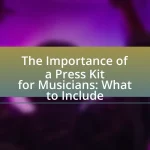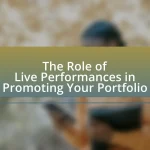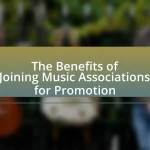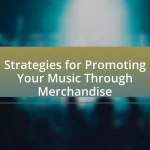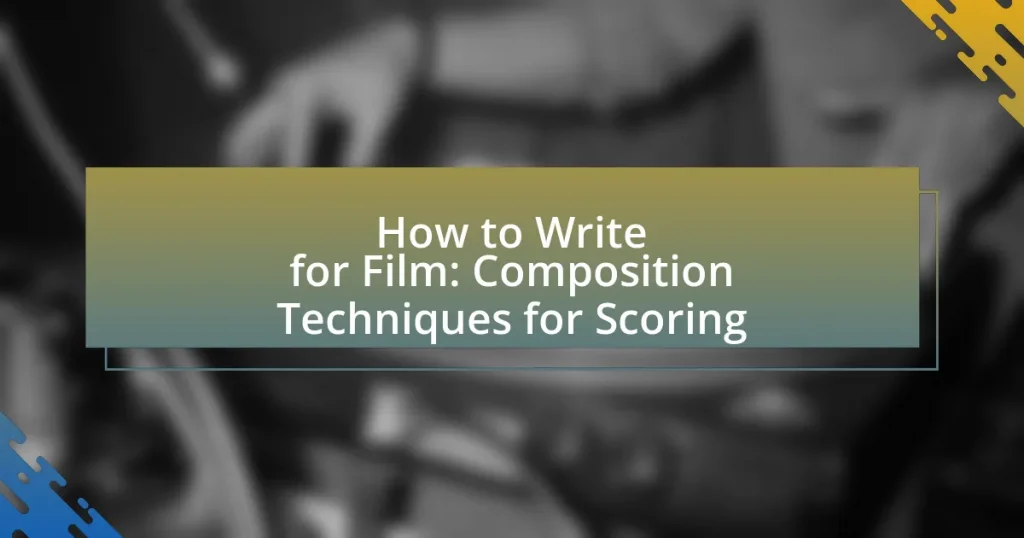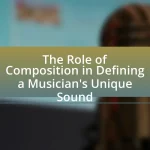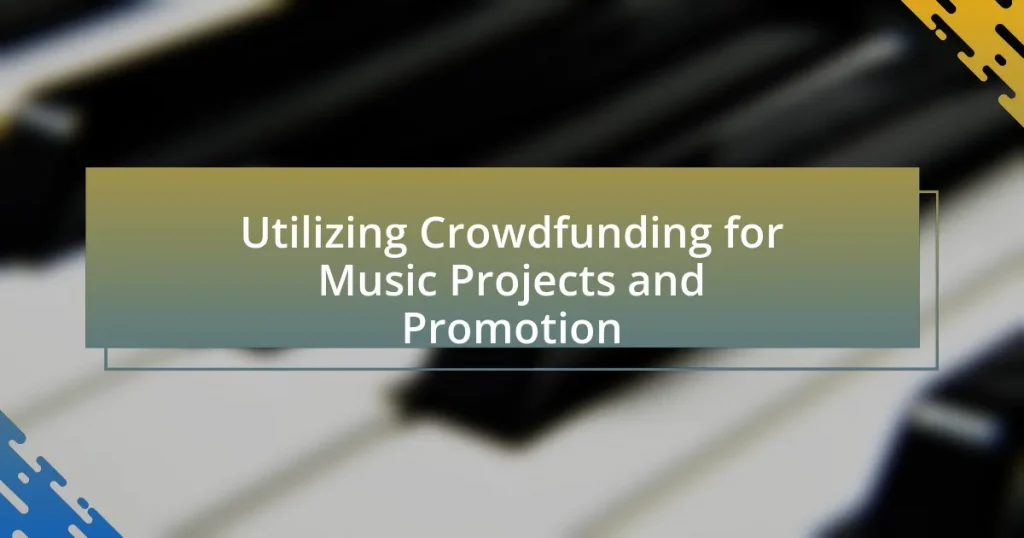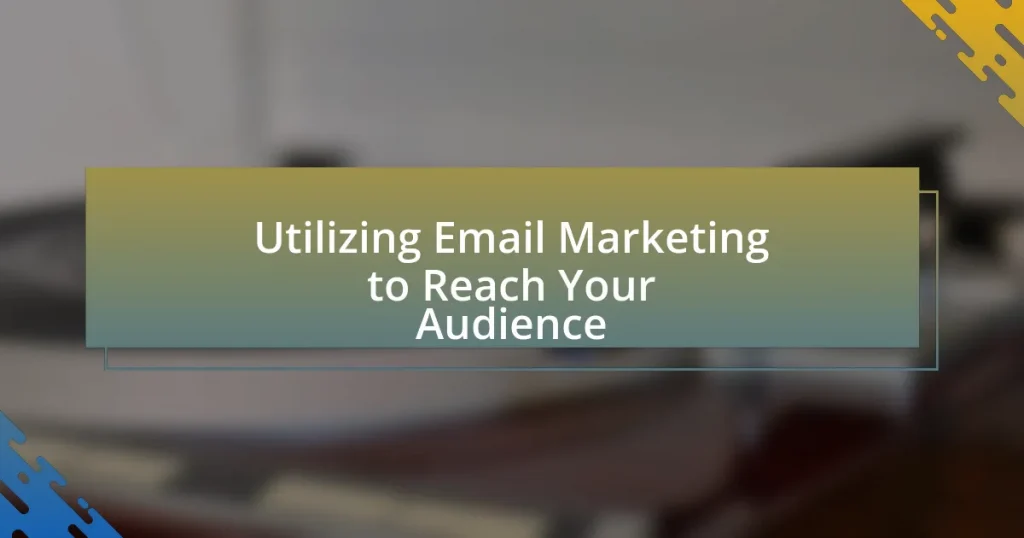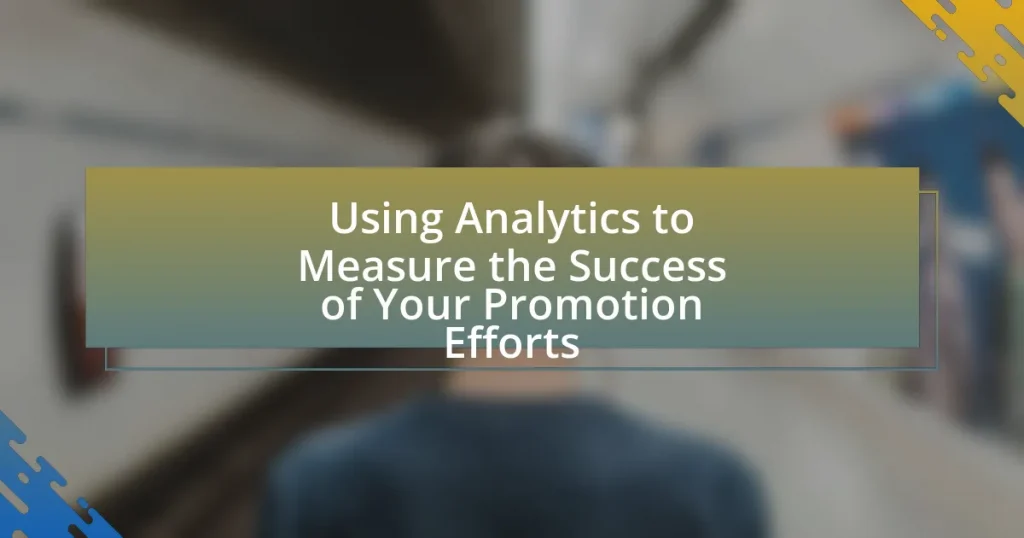The article focuses on the essential composition techniques for scoring films, emphasizing the fundamental principles of thematic development, emotional alignment, and synchronization with visual elements. It explores the unique challenges faced by composers, the influence of visual storytelling on music, and the critical role of emotion in film scoring. Additionally, it discusses practical techniques for matching music with on-screen action, the significance of rhythm and tempo, and best practices for collaboration between composers and filmmakers. The article also highlights the tools and technologies vital for film scoring, offering practical tips for aspiring composers to build their portfolios and network effectively within the industry.
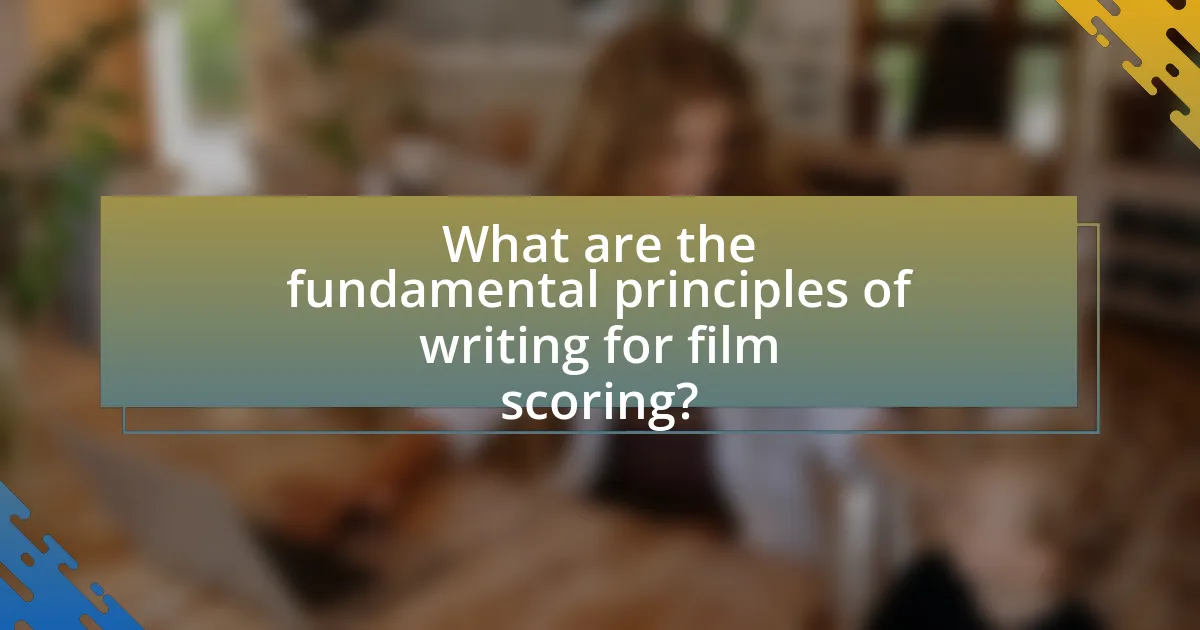
What are the fundamental principles of writing for film scoring?
The fundamental principles of writing for film scoring include thematic development, emotional alignment, and synchronization with visual elements. Thematic development involves creating memorable motifs that represent characters or ideas, enhancing narrative coherence. Emotional alignment ensures that the music reflects the emotional tone of scenes, guiding audience reactions effectively. Synchronization with visual elements, often referred to as “spotting,” requires composers to align musical cues with specific actions or transitions in the film, enhancing the storytelling experience. These principles are essential for creating impactful scores that resonate with viewers and support the film’s narrative structure.
How does film scoring differ from other forms of music composition?
Film scoring differs from other forms of music composition primarily in its purpose and context, as it is specifically designed to enhance the narrative and emotional impact of visual media. Unlike standalone music, film scores are created to synchronize with scenes, guiding audience emotions and reactions through timing and thematic development. For example, a study by the University of Southern California found that music in films can significantly influence viewers’ emotional responses, demonstrating the unique role of film scoring in storytelling.
What unique challenges do composers face in film scoring?
Composers face unique challenges in film scoring, primarily due to the need to synchronize music with visual elements and emotional cues. This synchronization requires precise timing and an understanding of the film’s narrative structure, as music must enhance the storytelling without overshadowing dialogue or sound effects. Additionally, composers often work under tight deadlines and budget constraints, which can limit creative exploration and experimentation. The collaborative nature of film scoring also presents challenges, as composers must navigate differing visions and feedback from directors and producers, requiring flexibility and adaptability in their creative process.
How does the visual element influence musical composition in film?
The visual element significantly influences musical composition in film by guiding the emotional tone and pacing of the score. Filmmakers use visuals to convey specific moods, actions, and themes, which composers interpret through musical motifs, instrumentation, and dynamics. For instance, a fast-paced action scene may prompt a composer to use rapid rhythms and intense instrumentation, while a serene landscape might inspire softer melodies and harmonies. This relationship is evident in films like “Inception,” where Hans Zimmer’s score mirrors the visual complexity and tension of the narrative, enhancing the viewer’s emotional experience. Thus, the interplay between visual storytelling and musical composition is crucial for creating a cohesive and impactful film.
What role does emotion play in film scoring?
Emotion plays a crucial role in film scoring by enhancing the narrative and influencing audience reactions. Film scores are designed to evoke specific feelings that align with the visual storytelling, guiding viewers’ emotional responses to scenes. For instance, a study by the University of Southern California found that music can significantly alter the perception of a film’s emotional tone, with certain musical elements like tempo and harmony directly affecting how audiences feel during key moments. This demonstrates that effective film scoring not only complements the visuals but also shapes the emotional landscape of the film, making it an essential component of cinematic storytelling.
How can composers effectively convey emotions through music?
Composers can effectively convey emotions through music by utilizing specific musical elements such as melody, harmony, rhythm, and dynamics. For instance, a minor key often evokes sadness, while a major key can create a sense of happiness or triumph. Research indicates that tempo influences emotional perception; faster tempos can generate excitement, while slower tempos may induce calmness or melancholy. Additionally, composers can use dynamics to emphasize emotional peaks, with crescendos building tension and decrescendos providing resolution. The combination of these elements allows composers to create a soundscape that resonates with the audience’s feelings, enhancing the emotional impact of the film.
What techniques can be used to match music with on-screen action?
Techniques to match music with on-screen action include synchronization, thematic scoring, and dynamic contrast. Synchronization involves aligning musical cues with specific visual events, such as a character’s movement or a dramatic moment, enhancing the emotional impact. Thematic scoring uses recurring musical motifs associated with characters or themes, providing continuity and depth to the narrative. Dynamic contrast refers to varying the intensity and volume of music to reflect the emotional tone of the scene, ensuring that the music complements rather than overwhelms the visuals. These techniques are widely used in film scoring to create a cohesive and engaging viewing experience.

What are the key composition techniques for scoring films?
Key composition techniques for scoring films include thematic development, orchestration, and the use of motifs. Thematic development involves creating a central theme that evolves throughout the film, enhancing emotional engagement. Orchestration refers to the arrangement of music for various instruments, which can significantly affect the mood and tone of scenes. The use of motifs, or recurring musical phrases associated with characters or ideas, helps to reinforce narrative elements and create cohesion in the score. These techniques are essential for effectively conveying the film’s emotional landscape and supporting storytelling.
How do melody and harmony contribute to film scoring?
Melody and harmony are essential components of film scoring, as they evoke emotions and enhance storytelling. Melody provides a memorable theme that can represent characters or ideas, creating an emotional connection with the audience. For instance, John Williams’ use of distinct melodies in “Star Wars” helps to define characters and their journeys. Harmony, on the other hand, supports the melody by adding depth and complexity, influencing the mood of a scene. For example, dissonant harmonies can create tension, while consonant harmonies can evoke feelings of resolution and peace. Together, melody and harmony shape the emotional landscape of a film, guiding the audience’s reactions and reinforcing the narrative.
What are the best practices for creating memorable melodies in film music?
The best practices for creating memorable melodies in film music include using simple, singable motifs, establishing a strong emotional connection, and ensuring thematic consistency throughout the score. Simple motifs are easier for audiences to remember and can be developed or varied throughout the film to maintain interest. Emotional connection is crucial, as melodies that resonate with the audience enhance the storytelling; for instance, John Williams’ scores often evoke strong emotions through memorable themes. Thematic consistency ensures that the melody aligns with the film’s narrative and character arcs, as seen in Hans Zimmer’s use of recurring themes to represent specific characters or ideas. These practices are supported by the success of numerous film scores that have become iconic due to their memorable melodies.
How can harmony enhance the emotional impact of a scene?
Harmony can enhance the emotional impact of a scene by creating a specific mood that resonates with the audience’s feelings. When composers use harmonious chords and progressions, they evoke emotions such as joy, sadness, tension, or resolution, which align with the narrative context. For instance, a major chord progression can instill feelings of happiness and triumph, while a minor progression often conveys sadness or conflict. Research in music psychology indicates that harmony influences emotional perception; studies show that listeners can identify emotional cues in music based on harmonic structures, reinforcing the connection between harmony and emotional response in film scoring.
What is the significance of rhythm and tempo in film scoring?
Rhythm and tempo are crucial elements in film scoring as they directly influence the emotional pacing and narrative flow of a film. The rhythm establishes the timing and movement of the music, which can enhance tension, excitement, or calmness, while the tempo dictates the speed at which the music unfolds, affecting the audience’s emotional response. For instance, a fast tempo can create urgency during action scenes, while a slower rhythm can evoke sadness or reflection in dramatic moments. Studies have shown that music with varying rhythms and tempos can significantly alter viewers’ perceptions of scenes, reinforcing the intended emotional impact and guiding audience reactions throughout the film.
How does rhythm influence the pacing of a film?
Rhythm significantly influences the pacing of a film by dictating the speed and flow of scenes, which affects audience engagement and emotional response. A well-structured rhythm can create tension or release, guiding viewers through the narrative. For instance, fast-paced rhythms, often achieved through quick cuts and upbeat music, can heighten excitement during action sequences, while slower rhythms can evoke contemplation or sadness in dramatic moments. Studies in film theory, such as those by David Bordwell, emphasize that rhythm in editing and sound design directly correlates with the perceived tempo of the film, impacting how audiences experience time within the story.
What techniques can be used to manipulate tempo for dramatic effect?
Techniques to manipulate tempo for dramatic effect include accelerando, ritardando, and syncopation. Accelerando gradually increases the speed of the music, creating a sense of urgency or excitement, often used in action scenes. Ritardando slows down the tempo, which can heighten tension or emphasize a moment of reflection, commonly found in dramatic or emotional sequences. Syncopation disrupts the regular flow of rhythm, adding unpredictability and enhancing the emotional impact of a scene. These techniques are widely utilized in film scoring to evoke specific feelings and enhance storytelling.
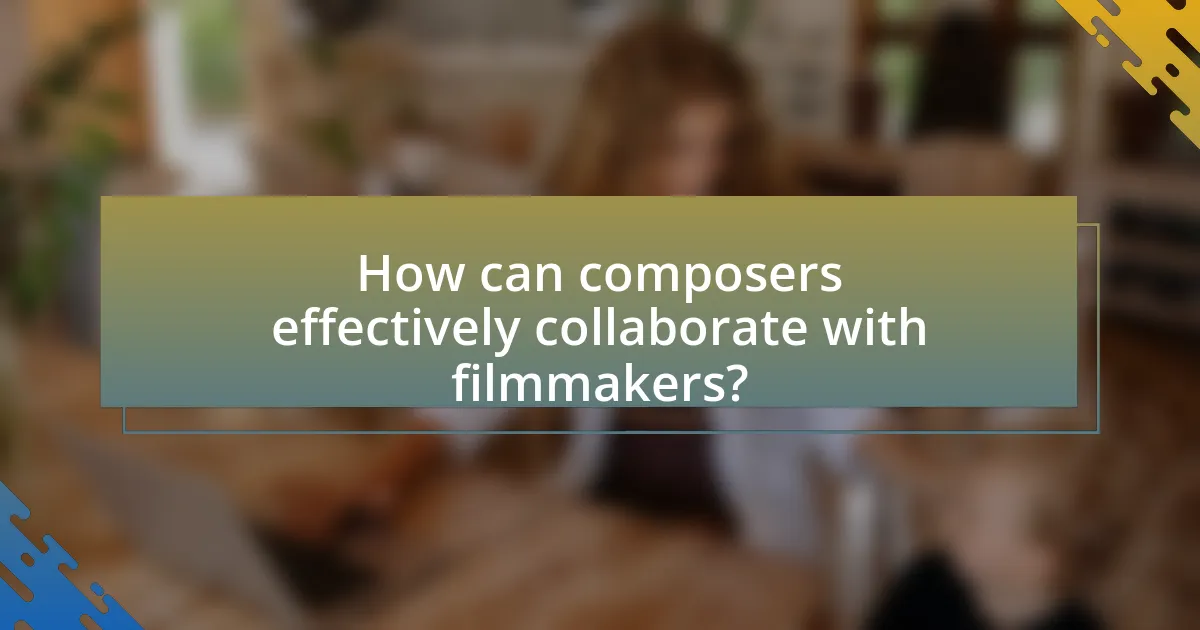
How can composers effectively collaborate with filmmakers?
Composers can effectively collaborate with filmmakers by establishing clear communication and understanding the film’s narrative and emotional tone. This involves regular meetings to discuss the director’s vision, sharing reference tracks, and providing feedback on the score’s alignment with the film’s pacing and mood. Research indicates that successful collaborations often include composers participating in early stages of production, allowing them to create music that enhances character development and story arcs. For instance, the collaboration between composer Hans Zimmer and director Christopher Nolan exemplifies how early involvement can lead to a cohesive audio-visual experience, as seen in films like “Inception” and “Dunkirk.”
What are the best practices for communication between composers and directors?
Effective communication between composers and directors involves establishing clear expectations, maintaining open dialogue, and utilizing collaborative tools. Clear expectations ensure that both parties understand the vision and requirements of the project, which can be achieved through detailed discussions and written briefs. Open dialogue fosters a creative environment where feedback can be shared constructively, allowing for adjustments to be made throughout the scoring process. Collaborative tools, such as shared digital platforms for file exchange and real-time feedback, enhance the workflow and ensure that both composers and directors are aligned on the project’s progress. These practices are essential for creating a cohesive score that complements the film’s narrative and emotional tone.
How can feedback be effectively integrated into the scoring process?
Feedback can be effectively integrated into the scoring process by establishing a structured review system that incorporates input from directors, producers, and test audiences at various stages of composition. This approach allows composers to refine their work based on specific, actionable insights, ensuring that the score aligns with the film’s emotional and narrative goals. Research indicates that iterative feedback loops, where composers present drafts and receive critiques, lead to more cohesive and impactful scores, as seen in successful films like “Inception,” where composer Hans Zimmer utilized feedback from director Christopher Nolan to enhance thematic elements.
What role does the spotting session play in film scoring collaboration?
The spotting session is crucial in film scoring collaboration as it establishes the specific moments in a film where music will be placed. During this session, the director and composer discuss the emotional tone and thematic elements required for each scene, ensuring that the score aligns with the film’s narrative. This collaborative process allows for clear communication of artistic vision, which is essential for creating a cohesive soundtrack that enhances the storytelling. The effectiveness of spotting sessions is evidenced by their widespread use in the industry, as they facilitate a shared understanding between filmmakers and composers, ultimately leading to a more impactful film score.
What tools and technologies are essential for film scoring?
Essential tools and technologies for film scoring include Digital Audio Workstations (DAWs), virtual instruments, and audio plugins. DAWs like Avid Pro Tools and Apple Logic Pro X provide the primary environment for composing, recording, and editing music. Virtual instruments, such as Native Instruments Kontakt and EastWest Play, offer realistic orchestral sounds and other instrument emulations, enabling composers to create rich soundscapes. Audio plugins, including effects like reverb and compression, enhance the final mix, ensuring high-quality sound production. These tools are widely used in the industry, as evidenced by their presence in numerous award-winning film scores.
How do digital audio workstations (DAWs) facilitate film scoring?
Digital audio workstations (DAWs) facilitate film scoring by providing composers with a comprehensive platform for recording, editing, and mixing audio. DAWs enable the integration of virtual instruments and sound libraries, allowing composers to create complex scores without the need for live musicians. Additionally, DAWs offer features such as MIDI sequencing, which allows for precise control over musical elements, and audio manipulation tools that enhance sound design. The ability to work with multiple tracks simultaneously and utilize automation for dynamic changes further streamlines the scoring process. This efficiency is supported by the widespread use of DAWs in the industry, with software like Avid Pro Tools and Apple Logic Pro being standard tools for film composers, demonstrating their critical role in modern film scoring.
What software and plugins are commonly used in film composition?
Commonly used software in film composition includes Digital Audio Workstations (DAWs) such as Avid Pro Tools, Apple Logic Pro, and Ableton Live. These DAWs provide essential tools for recording, editing, and mixing audio. Additionally, plugins like Native Instruments Kontakt, Spectrasonics Omnisphere, and EastWest Hollywood Orchestra are frequently utilized for their extensive libraries of virtual instruments and sound design capabilities. These tools are integral to the film scoring process, enabling composers to create high-quality soundtracks that enhance the visual narrative.
What are some practical tips for aspiring film composers?
Aspiring film composers should focus on developing a strong understanding of film structure and storytelling. This knowledge allows composers to create music that enhances the narrative and emotional impact of a film. Additionally, collaborating with filmmakers and attending film festivals can provide valuable networking opportunities and insights into the industry. Learning music software and technology is essential, as proficiency in digital audio workstations (DAWs) enables composers to produce high-quality scores efficiently. Furthermore, studying existing film scores and analyzing their techniques can inspire original compositions and improve one’s craft. Engaging in continuous practice and seeking feedback from peers can also refine a composer’s skills and artistic voice.
How can one build a portfolio that showcases film scoring skills?
To build a portfolio that showcases film scoring skills, one should create a diverse collection of original compositions that align with various film genres and styles. This includes scoring short films, student projects, or personal video projects to demonstrate versatility and creativity. Additionally, including detailed descriptions of each piece, such as the inspiration behind the score and the techniques used, enhances the portfolio’s depth. Collaborating with filmmakers or participating in film festivals can provide real-world examples of work, further validating the skills showcased. A well-organized online platform, such as a personal website or a professional profile on music-sharing sites, can effectively present this portfolio to potential clients or collaborators.
What networking strategies can help composers connect with filmmakers?
Composers can connect with filmmakers through targeted networking strategies such as attending film festivals, joining industry organizations, and leveraging social media platforms. Film festivals provide opportunities for composers to meet filmmakers in person, showcase their work, and engage in discussions about potential collaborations. Joining organizations like the American Society of Composers, Authors, and Publishers (ASCAP) or the Society of Composers and Lyricists (SCL) allows composers to access resources, workshops, and networking events specifically designed for industry professionals. Additionally, utilizing social media platforms like LinkedIn and Instagram enables composers to share their portfolios, connect with filmmakers, and participate in relevant conversations, thereby increasing their visibility within the film community.



